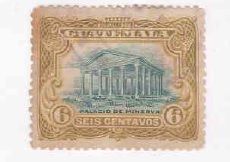Post by Gordon Lee on Sept 6, 2013 16:08:48 GMT -5
Greetings Fellow SB (ver. 2.0) Boarders
.
I came across this stamp and thought, wowzer, this is one snazzy stamp. Not so much because it is rare and valuable, because it's not. It is just a common old stamp with a nifty combination of colors.
.

.
GUATEMALA -- SCOTT 273.
.
In November of 1935, Guatemala issued a set of four stamps depicting their National Symbols (Scott 273-276). All four photogravure stamps are on non-watermarked paper and have a perforation gauged at 12-3/4. There are two three-centavos stamps. Both depict the national bird, the quetzal. The bird is in natural colors with a blue green background. The difference is one is framed in rose carmine (Scott 274) and the other in red orange (Scott 275). The Legislative Assembly Building in Guatemala City is shown on blue and carmine four-centavos National Symbol stamp (Scott 276).
.
The one-centavos shows a view of Lake Atitlan. I think the color combination is a doozy: brown and crimson. The arc of the postmark looks like it is nestled right naturally between the two volcano peaks.
.
Here is some of the stuff I learned from the internet about the lake. The word "Atitlan" is Mayan which means "at the water." The lake is the largest in Guatemala and is the deepest, at 340 meters, in Central America. It happens to be what is called an endorheic lake. I'll save you the trouble of looking that word up; it means it is a lake where the water does not flow to the sea.
.
Lake Atitlan is shaped by deep escarpments which surround it and by three volcanoes on its southern flank. In fact, the lake was made by a volcano that erupted over 840,000 years ago. Evidently the water in this dead volcano is still rising 'cause a couple of old Maya ruins have been discovered below the present day surface.
.
Back in 1958 Pan American World Airlines along with the Guatemalan government considered Lake Atitlan to be a major tourist attraction. It is thought to be one of the most beautiful lakes in the world. Pan Am thought it would be even more of a major attraction if the lake was stocked with a fish prized by anglers. So, a non-native species, the black bass, was introduced. The bass quickly took to its new home and began eating the native inhabitants of the lake. The predatory bass caused the elimination of more than two-thirds of the native fish species in the lake and contributed to the extinction of the Atitlan Grebe, a rare bird that lived only around Lake Atitlan. A look at the "Top 13 Things to Do at Lake Atitlan" on the TripAdvisor web page ( www.tripadvisor.com/Attractions-g292007-Activities-c25-Lake_Atitlan_Solola_Department_Western_Highlands.html ) fishing is not found. Wow.
.
Respectfully,
Gordon Lee
.
I came across this stamp and thought, wowzer, this is one snazzy stamp. Not so much because it is rare and valuable, because it's not. It is just a common old stamp with a nifty combination of colors.
.

.
GUATEMALA -- SCOTT 273.
.
In November of 1935, Guatemala issued a set of four stamps depicting their National Symbols (Scott 273-276). All four photogravure stamps are on non-watermarked paper and have a perforation gauged at 12-3/4. There are two three-centavos stamps. Both depict the national bird, the quetzal. The bird is in natural colors with a blue green background. The difference is one is framed in rose carmine (Scott 274) and the other in red orange (Scott 275). The Legislative Assembly Building in Guatemala City is shown on blue and carmine four-centavos National Symbol stamp (Scott 276).
.
The one-centavos shows a view of Lake Atitlan. I think the color combination is a doozy: brown and crimson. The arc of the postmark looks like it is nestled right naturally between the two volcano peaks.
.
Here is some of the stuff I learned from the internet about the lake. The word "Atitlan" is Mayan which means "at the water." The lake is the largest in Guatemala and is the deepest, at 340 meters, in Central America. It happens to be what is called an endorheic lake. I'll save you the trouble of looking that word up; it means it is a lake where the water does not flow to the sea.
.
Lake Atitlan is shaped by deep escarpments which surround it and by three volcanoes on its southern flank. In fact, the lake was made by a volcano that erupted over 840,000 years ago. Evidently the water in this dead volcano is still rising 'cause a couple of old Maya ruins have been discovered below the present day surface.
.
Back in 1958 Pan American World Airlines along with the Guatemalan government considered Lake Atitlan to be a major tourist attraction. It is thought to be one of the most beautiful lakes in the world. Pan Am thought it would be even more of a major attraction if the lake was stocked with a fish prized by anglers. So, a non-native species, the black bass, was introduced. The bass quickly took to its new home and began eating the native inhabitants of the lake. The predatory bass caused the elimination of more than two-thirds of the native fish species in the lake and contributed to the extinction of the Atitlan Grebe, a rare bird that lived only around Lake Atitlan. A look at the "Top 13 Things to Do at Lake Atitlan" on the TripAdvisor web page ( www.tripadvisor.com/Attractions-g292007-Activities-c25-Lake_Atitlan_Solola_Department_Western_Highlands.html ) fishing is not found. Wow.
.
Respectfully,
Gordon Lee















